Mayor Johnson Touts “One Milwaukee” Vision In State of City Speech
Public safety, an end to reckless driving, more bike lanes, lead lateral replacement and a city government back from the brink.
“Doubters and pessimists, we proved you wrong.”
Mayor Cavalier Johnson offered an upbeat assessment of Milwaukee’s present and future on Tuesday during his second State of the City speech.
“Today, the state of the city is promising. Key factors are aligning in very positive ways,” said Johnson.
The mayor’s speech touted a vision of “One Milwaukee,” a city that celebrates its diversity and embraces “shared desires for public safety, equitable economic opportunity and city services that serve the needs of every person.”
He addressed public safety concerns and positive indicators around it, while also announcing new visions for reducing lead poisoning and massively expanding the city’s network of bike lanes.
The speech marked a pivot from those given at the end of Tom Barrett‘s tenure, and the pre-recorded speech Johnson gave while serving as acting mayor in February 2022.
Instead of lamenting the city’s broken fiscal relationship with the state and the dire layoffs that were coming, Johnson was able to tout his successful “cot in the Capitol” strategy to get a deal done. The city is getting more shared revenue and will have its own 2% sales tax.
“We now have a solution that will overcome decades of fiscal problems and our city now has a path forward,” said the mayor, speaking to several hundred people at the BMO Pavilion at Henry Maier Festival Park.
But he also lamented that many of the policy provisions Republicans tied to the funding he never asked for, and outright opposed. “No matter how loudly I said no, the steamroller of political reality moved forward,” he said.
The mayor placed a special emphasis on thanking those that helped the deal, including County Executive David Crowley, Governor Tony Evers, County Board Chair Marcelia Nicholson, a number of civic organizations, Senator LaTonya Johnson and representatives Kalan Haywood II, Sylvia Ortiz-Velez, Christine Sinicki and Deb Andraca. The mayor also thanked the Republican Legislative leaders that compromised with the city.
Common Council President José G. Pérez got extended praise, which followed a meeting earlier in the day where his council colleagues had praised him for saving the deal from being far worse. Johnson also encouraged the council members to vote for the sales tax, noting the policy restrictions were in place whether the city took the money or not.
“I have shared a brighter vision for the future in which emergency responses are faster and libraries will be open, offering more innovative programs for our younger residents. That’s how we build One Milwaukee we can all be proud of,” said the mayor.
Johnson highlighted that a number of crime statistics are trending downward, including auto thefts falling nearly 40% versus two years ago. The FBI’s “Part 1” crimes, which include the most serious offenses, are down 14% versus this time last year and 20% versus two years ago. That includes a 31% year-over-year decrease in homicides.
“Safety is a cause we can all take part in. In my vision of One Milwaukee, everyone has a responsibility for reducing crime,” said Johnson. He encouraged residents to hold people accountable and report crimes, as well as mentoring and offering guidance to young people.
He also said the number of gun crimes remains “appalling” and called on gun owners to be responsible, locking up their weapons.
“Let me offer this example, in the City of Milwaukee, last year, 737 guns were stolen from cars. Think about that. That is hundreds of guns now in the hands of people who absolutely should not have firearms. If you can’t take your gun into a bar, a restaurant, a theater, or a sporting event, don’t bring it in the first place. Do not leave a gun in your car,” said the mayor.
Johnson, acknowledging the advocacy of U.S. Senator Tammy Baldwin and Congresswoman Gwen Moore, also called for stricter gun laws. It’s a refrain that has become common in Milwaukee mayoral speeches for some time.
The mayor made sure to tout the positive economic things happening in the city, including a low unemployment rate, and new headquarters or major offices by Komatsu Mining, Rite-Hite, Michels Corp., Milwaukee Tool, Northwestern Mutual and Fiserv.
Getting The Lead Out
The speech has long been used to announce ambitious policy goals and Johnson announced at least two Monday while doubling down on another.
“We have established a new goal of replacing all remaining lead service lines in Milwaukee within the next 20 years,” said Johnson. That’s down from the previous goal of more than 60 years.
The Milwaukee Water Works (MWW) is expecting a funding surge from the Bipartisan Infrastructure Law and, as of May, was projecting to replace a recording-breaking 1,700 laterals in 2024 and 2,200 in 2025.
But the city-owned utility and any private contractors it can hire will need to dramatically pick up the pace to eliminate the remaining 66,600 laterals. More than 3,300 per year will need to be replaced, effectively tripling the recent annual volume.
In May, MWW Superintendent Patrick Pauly discussed the utility’s plan to address one of the more complicated questions: how do you decide what laterals to replace next when you can’t replace all of them? The utility is working on an equity-focused strategy.
“It’s ambitious, but it’s something that’s important,” said the mayor in a media scrum after the meeting.
Johnson said there wasn’t a plan to expand lead paint abatement beyond the “significant” resources, a $26 million allocation, the Johnson-led council gave to the Milwaukee Health Department (MHD) in 2021 to expand its work on the issue. But the council, in 2022, clawed $1 million back to avoid service cuts elsewhere. MHD has previously said lead paint is the primary cause of lead poisoning in the city. A 2018 estimate said replacing all of the lead laterals would cost $750 million.
Johnson also used his speech to highlight stark racial health disparities, including lower insurance rates and higher rates of negative health events. “Childhood blood lead levels are twice as high among Black children compared to those of white children,” said the mayor.
Building Lots of Protected Bike Lanes
The mayor unveiled a second ambitious policy goal: to build or have under-development 50 miles of protected bike lanes by 2026.
The city has only a handful today, including on Kilbourn Avenue through Downtown and the Hawley Road bridge.
Johnson said people should expect to see new protected bike lanes emerge this year on W. Highland Avenue between N. 20th Street and Washington Park (N. 40th Street) and on W. Lapham Boulevard between S. 6th Street and S. Cesar E. Chavez Drive.
“There are numerous benefits to our bike lane plan,” said Johnson. “We are connecting the city with a new transportation alternative which adds safety for bike riders. We are promoting a way of getting around that improves both physical and mental health. And, the addition of protected bike lanes with a defined boundary from the car lane will promote traffic calming and additional safety for all roadway users.”
A number of projects are underway that include adding protected lanes with different types of configurations. They include rebuilding W. Walnut Street and W. National Avenue as well as planned projects like N. Van Buren Street through Downtown.
The mayor also touched on his first act in office – declaring reckless driving a crisis.
He noted the city is pursuing a four-pronged response, tasking city staff to address it across the board through a Vision Zero plan. The city recently hired Jessica Wineberg as its Vision Zero czar, responsible for coordinating inter-departmental action.
The city is also partnering with organizations on education, making physical changes to roadways and stepping up enforcement.
“I’ll let you in on a secret, our police are so forthcoming about their enforcement that they announce in advance where the High Visibility Enforcement Efforts will take place. Go on the website, you can see that right now, they are out on W. Silver Spring Drive west of N. 43rd Street, on the watch for reckless drivers,” said Johnson.
“I want more progress, but I have confidence we are moving in the right direction,” concluded the mayor.
He also revisited his earlier vision for reaching one million city residents, an increase of more than 400,000.
“That’s not just a numerical vision, but it’s a goal that helps us think big,” said the mayor. “Yes, it’s ambitious, but let’s be ambitious.”
Johnson, perhaps borrowing a page from Schitt’s Creek, walked off stage to Tina Turner‘s “The Best.”
Why did the speech happen in June instead of February? “Nothing says it has to happen in February,” said Johnson, sidestepping the question and touting the outdoor venue. But delaying until June allowed the mayor to speak after the deal was brokered with the state, yielding an upbeat speech instead of one designed to attempt to placate outstate Republicans and civic leaders.
Photos
If you think stories like this are important, become a member of Urban Milwaukee and help support real, independent journalism. Plus you get some cool added benefits.
Political Contributions Tracker
Displaying political contributions between people mentioned in this story. Learn more.
- March 29, 2016 - Tom Barrett received $100 from LaTonya Johnson
- August 13, 2015 - Cavalier Johnson received $25 from David Crowley
- May 5, 2015 - José G. Pérez received $10 from Cavalier Johnson


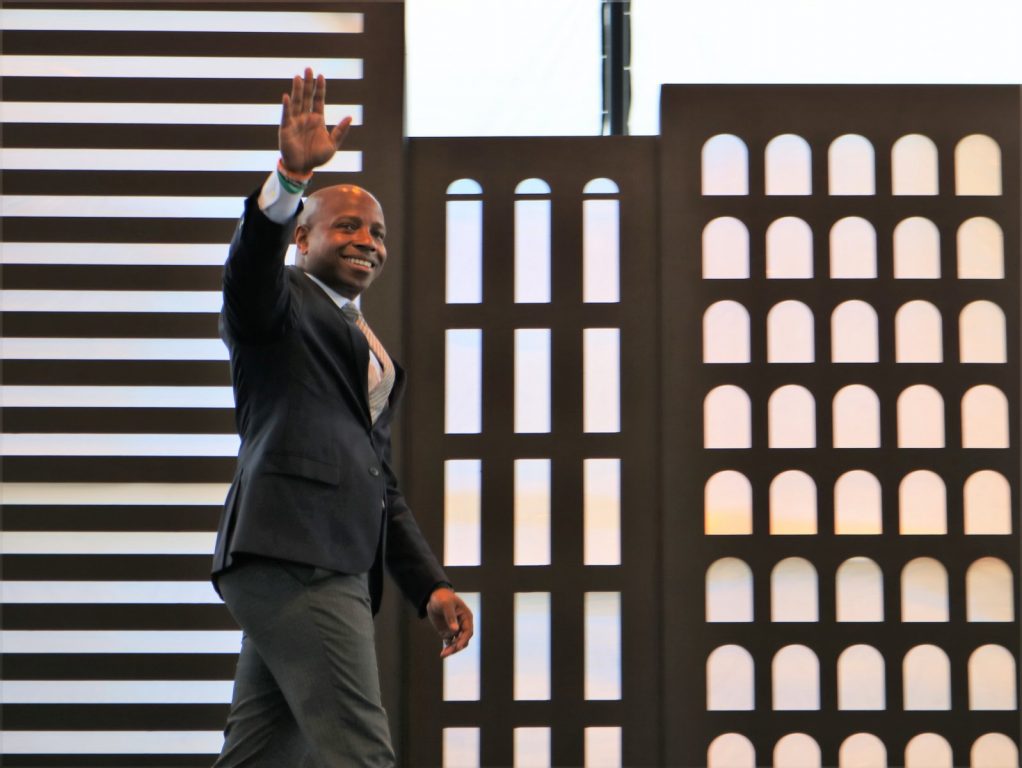
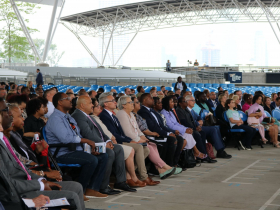
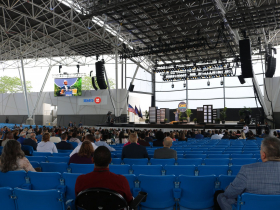
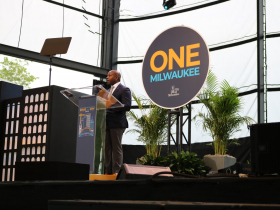
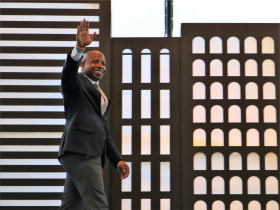
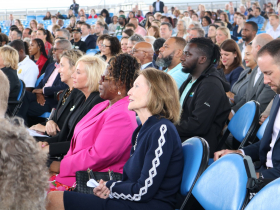
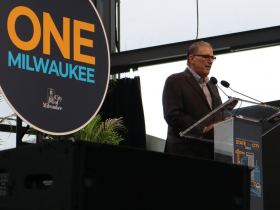


















Milwaukee is fortunate to have a young, energetic and intelligent mayor who is practical yet idealistic and optimistic for Milwaukee. His political acumen and energy are just what the city needs!